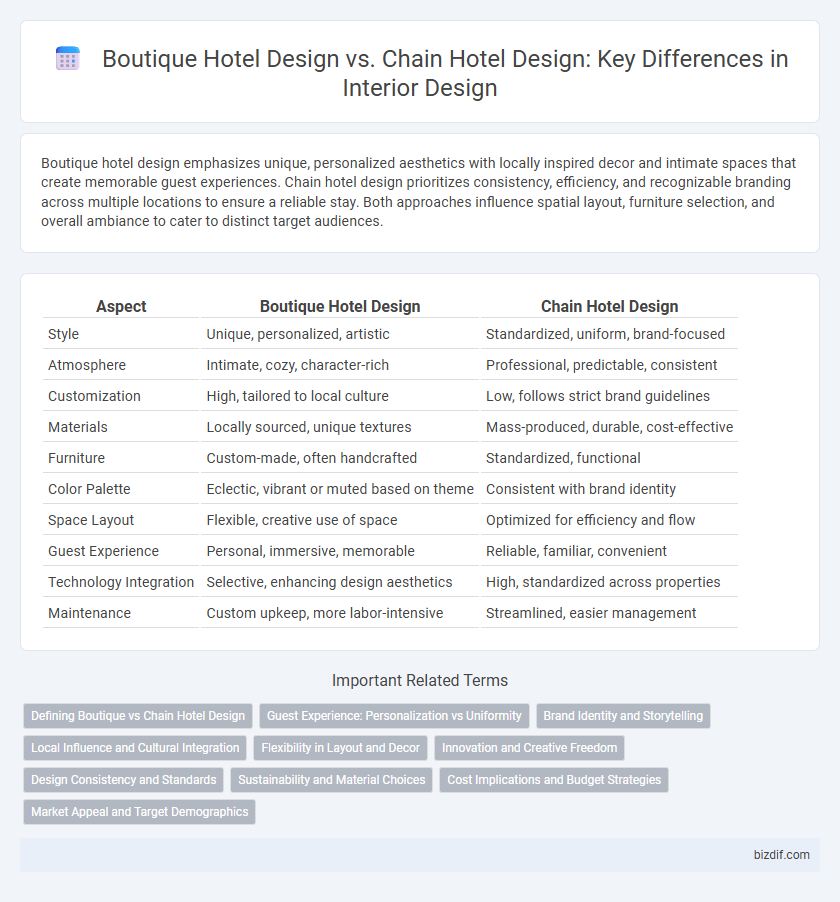Boutique hotel design emphasizes unique, personalized aesthetics with locally inspired decor and intimate spaces that create memorable guest experiences. Chain hotel design prioritizes consistency, efficiency, and recognizable branding across multiple locations to ensure a reliable stay. Both approaches influence spatial layout, furniture selection, and overall ambiance to cater to distinct target audiences.
Table of Comparison
| Aspect | Boutique Hotel Design | Chain Hotel Design |
|---|---|---|
| Style | Unique, personalized, artistic | Standardized, uniform, brand-focused |
| Atmosphere | Intimate, cozy, character-rich | Professional, predictable, consistent |
| Customization | High, tailored to local culture | Low, follows strict brand guidelines |
| Materials | Locally sourced, unique textures | Mass-produced, durable, cost-effective |
| Furniture | Custom-made, often handcrafted | Standardized, functional |
| Color Palette | Eclectic, vibrant or muted based on theme | Consistent with brand identity |
| Space Layout | Flexible, creative use of space | Optimized for efficiency and flow |
| Guest Experience | Personal, immersive, memorable | Reliable, familiar, convenient |
| Technology Integration | Selective, enhancing design aesthetics | High, standardized across properties |
| Maintenance | Custom upkeep, more labor-intensive | Streamlined, easier management |
Defining Boutique vs Chain Hotel Design
Boutique hotel design emphasizes unique, personalized aesthetics that reflect local culture and artistic flair, creating intimate, memorable guest experiences. Chain hotel design focuses on standardized layouts and branding to ensure consistency, efficiency, and recognizable service across multiple locations worldwide. The distinction lies in boutique hotels prioritizing individuality and localized charm, whereas chain hotels value uniformity and operational scalability.
Guest Experience: Personalization vs Uniformity
Boutique hotel design emphasizes personalized guest experiences through unique decor, tailored services, and local cultural influences, creating a distinctive atmosphere that resonates with individual preferences. Chain hotel design focuses on uniformity, ensuring consistent service standards, room layouts, and amenities across multiple locations to provide guests with predictable comfort and reliability. This contrast highlights how boutique hotels prioritize customization while chain hotels deliver efficiency and familiarity in guest experience.
Brand Identity and Storytelling
Boutique hotel design emphasizes unique brand identity and storytelling through personalized decor, local cultural influences, and bespoke guest experiences that create emotional connections. Chain hotel design prioritizes consistency, standardized aesthetics, and recognizable brand elements to ensure familiarity and reliability across multiple locations. This contrast highlights boutique hotels' ability to craft distinctive narratives versus chain hotels' focus on uniform brand presence.
Local Influence and Cultural Integration
Boutique hotel design emphasizes local influence and cultural integration by incorporating regional art, materials, and architectural styles that reflect the surrounding community's identity. Chain hotel design often follows standardized aesthetics to ensure brand consistency, limiting unique local expressions but providing familiar environments for global travelers. Embracing local culture in boutique hotels enhances guest experience through authentic, place-specific ambiance that differentiates them from uniform chain properties.
Flexibility in Layout and Decor
Boutique hotel design offers greater flexibility in layout and decor, allowing for unique, personalized spaces that reflect local culture and individual style. Chain hotel design typically follows standardized floor plans and decor to maintain brand consistency across locations, limiting customization options. This flexibility in boutique hotels enhances guest experience through distinctive atmospheres, while chain hotels prioritize operational efficiency and uniformity.
Innovation and Creative Freedom
Boutique hotel design embraces innovation and creative freedom through personalized aesthetics and unique thematic elements, fostering distinct guest experiences that reflect local culture and artistic expression. In contrast, chain hotel design prioritizes standardized layouts and brand consistency, often limiting opportunities for creative experimentation but ensuring predictable comfort and operational efficiency. This difference allows boutique hotels to push design boundaries while chain hotels maintain scalable and reliable environments.
Design Consistency and Standards
Boutique hotel design emphasizes unique aesthetics and personalized decor, allowing for greater flexibility and creative expression tailored to the location and target clientele. Chain hotel design maintains strict design consistency and standardized features across all properties to ensure brand recognition and a predictable guest experience. This balance between distinctiveness and uniformity defines the competitive dynamics of hospitality design strategies.
Sustainability and Material Choices
Boutique hotel design emphasizes sustainability by incorporating locally sourced, eco-friendly materials and unique, handcrafted decor that reduces environmental impact. Chain hotel design often relies on standardized, mass-produced materials that prioritize durability and cost-efficiency, potentially compromising sustainable practices. Both approaches benefit from integrating energy-efficient systems and sustainable sourcing to enhance environmental responsibility in the hospitality industry.
Cost Implications and Budget Strategies
Boutique hotel design often entails higher upfront costs due to customized interiors, unique furnishings, and artisanal materials, demanding flexible budget strategies that prioritize design innovation and guest experience over standardization. Chain hotel design benefits from economies of scale, utilizing standardized layouts, bulk purchasing, and repeatable design templates, effectively reducing overall capital expenditure and operational costs. Strategic allocation of funds in boutique hotels emphasizes distinctive aesthetics and personalized amenities, whereas chain hotels focus on cost control and maximizing efficiency through uniformity.
Market Appeal and Target Demographics
Boutique hotel design emphasizes unique aesthetics and personalized experiences to attract affluent travelers and millennials seeking exclusivity and local culture immersion. Chain hotel design prioritizes brand consistency and broad market appeal, targeting business travelers and families looking for predictable comfort and standardized amenities. Market segmentation shows boutique hotels excel in niche urban markets, while chain hotels dominate large-scale destinations with high guest turnover.
Boutique hotel design vs Chain hotel design Infographic

 bizdif.com
bizdif.com